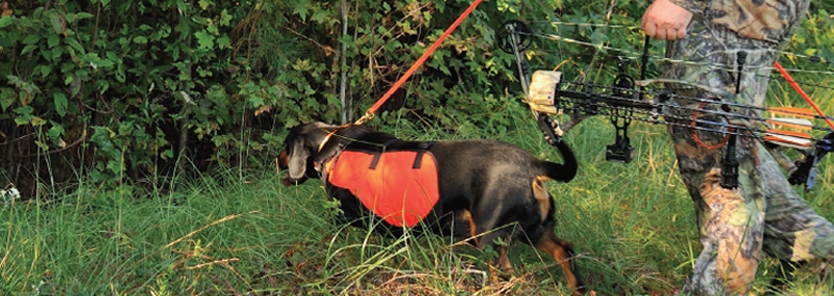What to look for in Deer Tracking Dogs
Culbertson is head guide at Tara Wildlife, a “bow only” hunting operation, near Vicksburg, Mississippi. During an average year, Culbertson depends on deer tracking dogs to locate an average of 150 deer shot by Tara’s clients.
“We roll in a new group of hunters twice a week at Tara. Before that group goes to the stand each hunter attends an orientation on safety, regulations, what to shoot and what to do after the shot,” said Culbertson. “During orientation, hunters are instructed to go to their deer if they see it fall. If it runs out of sight they are told to stay in their stand and do not try to find the deer. We are constantly training new dogs to find wounded deer. We use a dog to find every deer shot at Tara.”
“Almost every dog can find a deer shot through the lungs, but it takes well trained dog with guts to find a deer after a marginal hit. Tara borders the Mississippi River so we deal with a lot of water and these deer do not hesitate to hit the water when arrowed. That makes conventional tracking very hard if not impossible.”
“We have first, second and third string dogs,” said Culbertson. “We start taking dogs on tracks before they are a year old. Young dogs make mistakes but learn from them. Once a dog reaches 4-5 years of age he stops making those silly mistakes. Experience is the difference. Our dogs find 90% of the mortally wounded deer they track.”
Traits needed by good deer tracking dogs:
1. Independence:
When I look for a new dog to train I concentrate on newborn puppies. I watch the litter and look for the pup that stays to itself and muscles its litter mates out of the way when it’s time to nurse. More often than not this will be a male pup. That me-first attitude translates into a dog with confidence and self-reliance needed to find a wounded deer.
2. Eager to Please:
Bonding is critical with an independent dog. From the time that pup is weaned it stays with me everywhere I go. It eats when I eat and sleeps when I sleep. I talk to it like I talk to a person. I reward good behavior and correct bad. Once the pup bonds with you it will be eager to please, making training an easier job.
3. Nose:
The ability to smell is critical for a blood trailing dog. Not every trail will be the red carpet of blood we all hope for. Often, there is very little blood. The dog has to be able to discern the scent of a wounded deer from other deer and follow that scent wherever it goes.
4. Drive:
Drive cannot be taught. It has to be in the dog from the beginning. Drive is what makes the dog finish a track no matter how long or difficult.
5. Stamina:
Stamina is the ability to go day after day, track after track. By the end of season our dogs have lost 20% of their body weight, have no hair on their nose and around their eyes and are just plain tired. Stamina is the ability to go every day, tired or not. Several years ago, I had the pleasure to hunt at Tara. Culbertson drove me to a hang-on stand located on the edge of a large, backwater slough. Just before dark a mature 8 pointer swam the slough to the ridge where I was perched. When he was 30 yards from my stand I put an arrow just behind his shoulder and watched him bound out of sight. The last thing I heard was the sound of a deer running into water.
~
For more from GameKeeper Farming For Wildlife like What to look for in Deer Tracking Dogs, join our weekly newsletter or subscribe to GameKeepers Magazine. Your source for information, equipment, know-how, deals and discounts to help you get the most from every hard-earned moment in the field.









